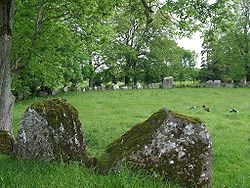
Grange stone circle
Encyclopedia

Lough Gur
Lough Gur is a lake in County Limerick, Ireland between the towns of Herbertstown and Bruff. The lake forms a horseshoe shape at the base of Knockadoon Hill and some rugged elevated countryside. It is one of Ireland's most important archaeological sites...
in County Limerick
County Limerick
It is thought that humans had established themselves in the Lough Gur area of the county as early as 3000 BC, while megalithic remains found at Duntryleague date back further to 3500 BC...
, Ireland
Republic of Ireland
Ireland , described as the Republic of Ireland , is a sovereign state in Europe occupying approximately five-sixths of the island of the same name. Its capital is Dublin. Ireland, which had a population of 4.58 million in 2011, is a constitutional republic governed as a parliamentary democracy,...
, is situated beside the Limerick
Limerick
Limerick is the third largest city in the Republic of Ireland, and the principal city of County Limerick and Ireland's Mid-West Region. It is the fifth most populous city in all of Ireland. When taking the extra-municipal suburbs into account, Limerick is the third largest conurbation in the...
-Kilmallock
Kilmallock
Kilmallock or Kilmalloc is a town in south County Limerick, Ireland, near the border with County Cork. There is a Dominican Priory in the town and King's Castle . The remains of medieval walls which encircled the settlement are still visible. The Dublin–Cork railway line passes by the town,...
road, 4 km north of Bruff
Bruff
Bruff is a town in east County Limerick, in the midwest of Ireland, located on the old Limerick–Cork road . The town lies on the Morning Star river, with two bridges in the town itself...
. Grid Ref: R640410, Latitude: 52.51, Longitude: -8.54.
Features
The stone circle comprises a ring of continuous uprights up to 2.8m high, with a diameter of 45m and backed by an earthen bank 9m wide and about 1.2m tall. The entrance on the eastern side is paved and flanked by uprights. Clay has been packed down to a depth of 60 cm across the whole area of the enclosure. On excavation it was found to be littered with late NeolithicNeolithic
The Neolithic Age, Era, or Period, or New Stone Age, was a period in the development of human technology, beginning about 9500 BC in some parts of the Middle East, and later in other parts of the world. It is traditionally considered as the last part of the Stone Age...
Beaker
Beaker culture
The Bell-Beaker culture , ca. 2400 – 1800 BC, is the term for a widely scattered cultural phenomenon of prehistoric western Europe starting in the late Neolithic or Chalcolithic running into the early Bronze Age...
pottery, which seemed to have been deliberately smashed. Its near perfect shape and the discovery of a posthole in the very center of the enclosure, indicates that the circle was measured out from a central stake with a rope. Twelve large orthostats have been placed at intervals around the stone ring, each standing directly opposite one of the other 'axial' stones. The stones are contiguous rather than free-standing, and the surrounding bank makes it look more like a form of henge monument than a conventional stone circle. This embankment and the precise arrangement of orthostats suggest that this site had a ritual purpose.
It is the largest standing stone circle in Ireland, 150 feet in diameter and enclosed by 113 standing stones. The largest stone is Ronnach Croim Duibh (the Black Stone) and is over 13 feet high and weighs 40 tons. The stone circle is aligned with the rising sun at the Summer Solstice
Solstice
A solstice is an astronomical event that happens twice each year when the Sun's apparent position in the sky, as viewed from Earth, reaches its northernmost or southernmost extremes...
on the morning of which the sun shines down directly in the center of the circle. The entrance stones are matched by a pair of equally impressive slabs on the southwest side, whose tops slope down towards each other to form a v-shape. During excavations no structures were found but two hearths, a few un-burnt human bones, some animal bones (mainly cattle), some bronze materials and numerous Neolithic pottery pieces were discovered.
A short distance to the north-north east of the main stone circle, is a second smaller circle, also constructed of large stones. To the north of this is a large leaning standing stone.

